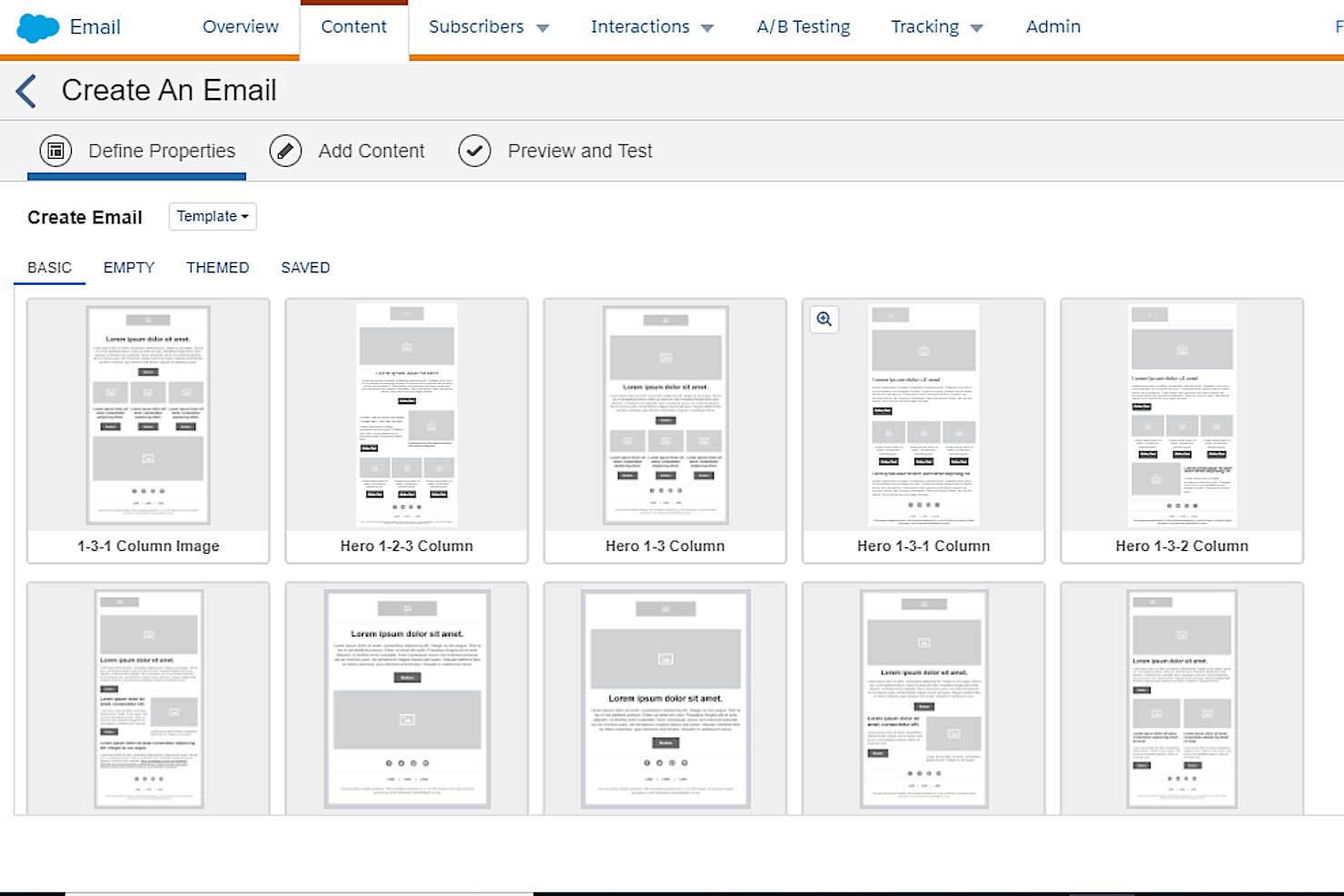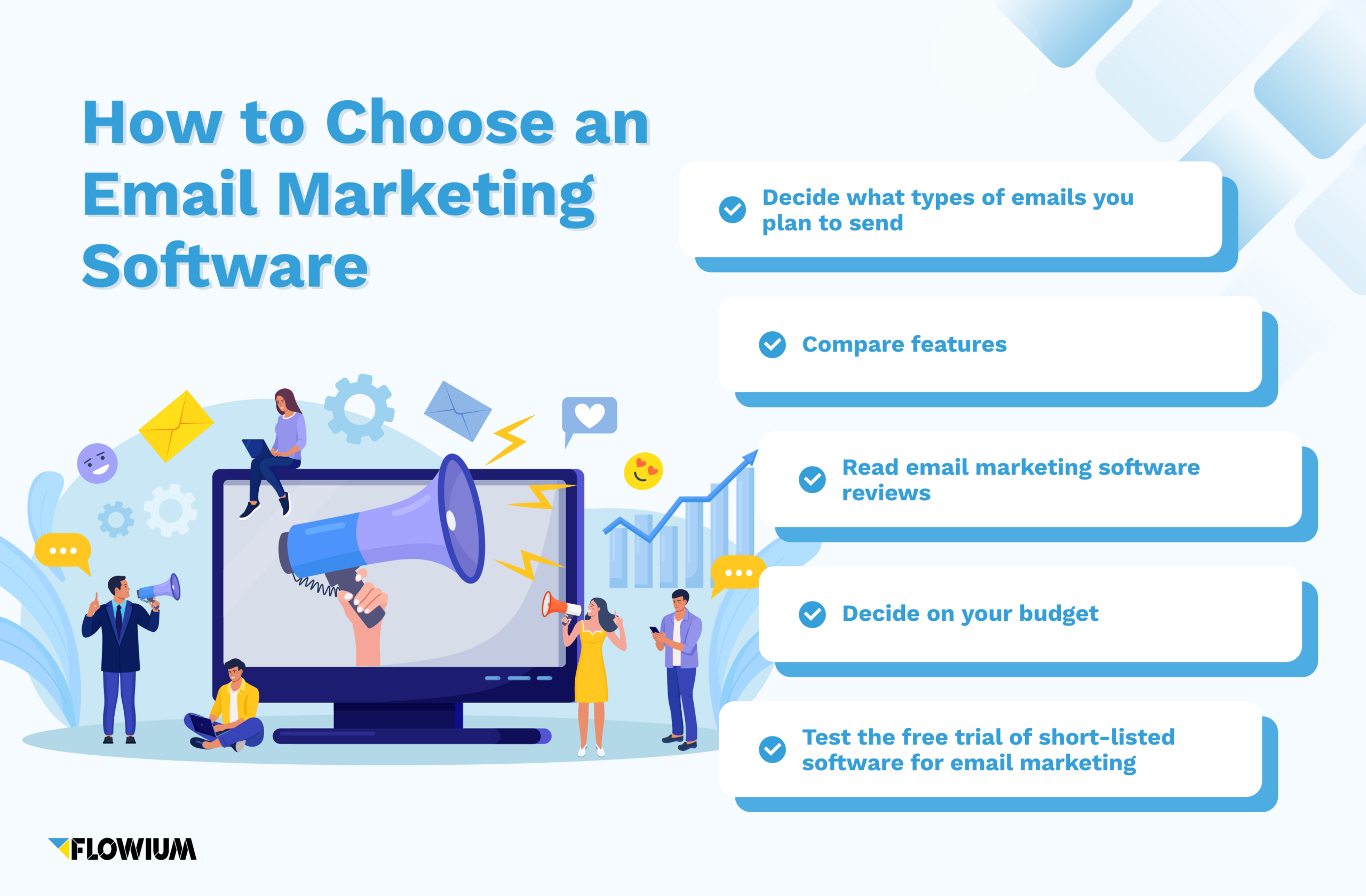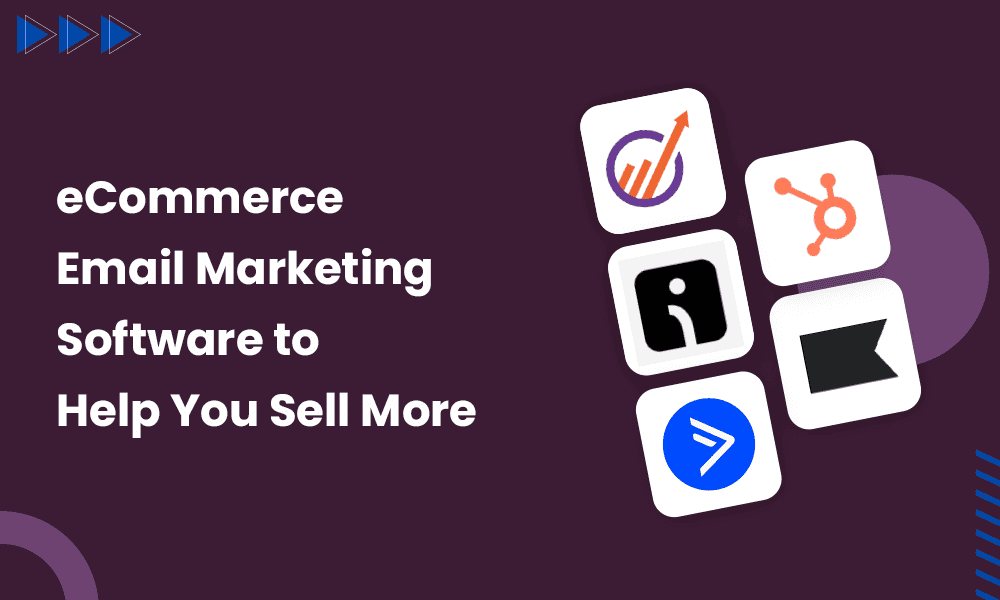Ecommerce Email Marketing Tool streamlines customer communication and boosts sales. It automates campaigns, saving time and increasing engagement.
| Tool | Description | Price | Visit Site |
|---|---|---|---|
| Mailchimp | Comprehensive email marketing with automation, templates, and analytics. Includes basic AI for recommendations. | Free, Paid plans from $299/month | visit site |
| Sendinblue | Email marketing and SMS with automation and segmentation features. Offers AI-based send-time optimization. | Free, Paid plans from $65/month | visit site |
| Constant Contact | User-friendly tool with event marketing and social media integration. Limited AI for recommendations. | Paid plans $9.99 – $45/month | visit site |
| ActiveCampaign | Advanced automation, CRM, and customer experience tools. Uses machine learning for predictive analytics. | Paid plans $29 – $149/month | visit site |
| Klaviyo | Targeted email and SMS marketing for eCommerce. Features AI-driven product recommendations. | Free, Paid plans from $700/month | visit site |
| GetResponse | Email marketing, landing pages, and webinars combined. Has AI-powered recommendations. | Paid plans $19 – $119/month | visit site |
| HubSpot | Comprehensive inbound marketing and CRM platform. Includes AI for segmentation and automation. | Free, Paid plans from Custom Pricing | visit site |
| Benchmark Email | Simple drag-and-drop email marketing solution. No AI features. | Free, Paid plans from $45/month | visit site |
| Zoho Campaigns | Part of Zoho Suite with integration to other business tools. Basic AI for suggestions. | Free, Paid plans from $25/month | visit site |
| Brevo | Advanced segmentation, automation, and personalization capabilities. Features AI-driven send-time optimization. | Free, Paid plans from $83/month | visit site |
Ecommerce businesses thrive on effective customer interactions. An email marketing tool transforms how businesses reach their audience, offering tailored messages that resonate. Automation features ensure consistent communication without manual effort. This tool helps segment audiences, craft personalized content, and track performance metrics.
Integrating with ecommerce platforms, it simplifies the marketing process. Enhanced analytics offer insights into customer behavior, enabling data-driven decisions. The right tool can elevate customer relationships, drive repeat purchases, and increase revenue. For ecommerce success, leveraging a specialized email marketing tool is essential.
Introduction To Ecommerce Email Marketing
Ecommerce email marketing is a powerful tool for online businesses. It helps connect with customers directly. Through well-crafted emails, businesses can boost sales and foster customer loyalty.
Importance Of Email Marketing
Email marketing is crucial for ecommerce success. It allows businesses to reach customers instantly. Sending personalized content increases engagement and conversions.
Benefits of Email Marketing:
- Direct communication with customers
- High return on investment (ROI)
- Easy to track and measure
- Personalized customer experience
A well-executed email campaign can drive repeat purchases. It also helps in promoting new products and special offers.
Current Trends
Staying updated with email marketing trends is vital. It keeps your strategies fresh and effective.
Key Trends in Email Marketing:
- Automation: Use automated emails for welcome messages and follow-ups.
- Personalization: Tailor emails based on customer preferences and behavior.
- Interactive Content: Include videos, quizzes, and polls to engage users.
- Mobile Optimization: Ensure emails are mobile-friendly for better reach.
By embracing these trends, ecommerce businesses can stay competitive. Modern email marketing tools simplify these tasks. They help create and manage effective campaigns.
| Trend | Benefit |
|---|---|
| Automation | Saves time and increases efficiency |
| Personalization | Improves customer engagement |
| Interactive Content | Boosts user interaction |
| Mobile Optimization | Enhances email accessibility |
Conclusion: Leveraging these trends in email marketing can lead to significant growth. Use the right tools to implement these strategies effectively.

Credit: theecommmanager.com
Benefits Of Automation In Email Marketing
Automating your email marketing can transform your ecommerce business. It saves time, ensures consistency, and increases engagement. Discover the key benefits below.
Time-saving
Automation allows you to schedule emails in advance. This saves you from sending each email manually.
Consider the time spent on creating and sending emails. With automation, you can focus on other important tasks.
Automated workflows handle repetitive tasks. This frees up your time for strategic planning.
Personalization At Scale
Automation helps you personalize emails for each customer. This boosts engagement and conversion rates.
Segment your audience based on behavior, preferences, and purchase history. Then, send targeted emails automatically.
Here is a table showing benefits of personalized emails:
| Benefit | Impact |
|---|---|
| Higher Open Rates | Customers are more likely to open personalized emails. |
| Increased Sales | Personalized recommendations drive more purchases. |
| Better Customer Loyalty | Personalized emails make customers feel valued. |
Personalization at scale ensures every customer feels special. Automated tools make this possible.
Key Features Of An Effective Tool
Email marketing is a powerful tool for ecommerce businesses. To fully harness its potential, choosing the right email marketing tool is essential. The most effective tools come with a range of features designed to optimize your campaigns and boost engagement. Let’s explore the key features that make an email marketing tool effective.
Segmentation
Segmentation allows you to divide your email list into smaller groups. This helps in sending targeted emails to different audiences.
- Demographic Segmentation: Group customers by age, gender, or location.
- Behavioral Segmentation: Segment based on past purchases or browsing history.
- Psychographic Segmentation: Group by interests or lifestyle choices.
Effective segmentation increases the relevance of your emails. It leads to higher engagement rates and conversions.
A/b Testing
A/B Testing, also known as split testing, is a critical feature. It lets you compare two versions of an email to see which performs better.
| Version A | Version B |
|---|---|
| Subject Line A | Subject Line B |
| Call-to-Action A | Call-to-Action B |
With A/B testing, you can test:
- Subject lines
- Email content
- Call-to-action buttons
Use the results to optimize your emails for better performance.
Setting Up Your Email Marketing Tool
Setting up your email marketing tool is crucial for ecommerce success. It’s the foundation of your email marketing strategy. Start by choosing the right tool and integrating it with your ecommerce platform.
Choosing The Right Tool
Selecting the perfect email marketing tool is essential. There are many options available, so consider your business needs. Look for features like:
- Automation: Automate emails based on customer behavior.
- Personalization: Customize emails for individual customers.
- Analytics: Track open rates, clicks, and conversions.
Comparing different tools can help you make the best choice. Here’s a simple comparison table:
| Tool | Automation | Personalization | Analytics |
|---|---|---|---|
| Tool A | Yes | Yes | Yes |
| Tool B | No | Yes | Yes |
| Tool C | Yes | No | Yes |
Integration With Ecommerce Platforms
Integrating your email marketing tool with your ecommerce platform is vital. This ensures smooth data flow between systems. Most tools offer built-in integrations for popular platforms like:
- Shopify
- WooCommerce
- BigCommerce
Follow these general steps to integrate your tool:
- Log in to your email marketing tool.
- Navigate to the integrations section.
- Select your ecommerce platform.
- Follow the on-screen instructions to complete the integration.
Successful integration allows for automated email campaigns. You can send personalized recommendations, abandoned cart reminders, and more.
Crafting Engaging Email Campaigns
Creating engaging email campaigns can boost your eCommerce success. Effective emails can drive sales and increase customer loyalty. This section will guide you on crafting compelling campaigns.
Subject Lines
Your subject line is the first thing readers see. It should grab attention immediately.
- Keep it short and catchy (50 characters or less).
- Use action words to encourage clicks.
- Personalize with the recipient’s name.
- Create a sense of urgency or curiosity.
Examples:
| Effective Subject Line | Reason |
|---|---|
| John, Your Exclusive Offer Awaits! | Personalization |
| Last Chance: 50% Off Ends Tonight! | Urgency |
| Discover Our Latest Collection Now! | Curiosity |
Content Strategies
The content of your email should be engaging and relevant. Focus on delivering value to your readers.
- Personalization: Use the recipient’s name and past purchase history.
- Visual Appeal: Include high-quality images and a clear layout.
- Clear Call-to-Action (CTA): Ensure your CTA stands out and is easy to find.
- Mobile-Friendly Design: Most emails are opened on mobile devices. Optimize for small screens.
- Relevant Content: Tailor your message to the recipient’s interests.
Example Structure:
Header: Attractive image or logo
Greeting: Personalized with the recipient’s name
Main Content: Brief, engaging text with visuals
CTA: Clear button or link
Footer: Contact information and unsubscribe link
By focusing on these strategies, your email campaigns can drive better results. Remember, the key is to engage and provide value to your readers.

Credit: flowium.com
Automated Workflows For Better Engagement
Automated workflows in eCommerce email marketing drive better engagement. They save time and deliver personalized messages to customers. Automated workflows ensure timely and relevant communication. Below are key workflows to consider.
Welcome Series
First impressions matter. A Welcome Series engages new subscribers immediately. These emails introduce your brand and offer incentives.
- Send a warm welcome email upon signup.
- Include discount codes or special offers.
- Share links to popular products or content.
Ensure each email is personal and relevant. This boosts customer interest and loyalty.
Cart Abandonment Emails
Many shoppers leave items in their carts. Cart Abandonment Emails remind them to complete the purchase.
- Send a reminder email within an hour.
- Include images of the abandoned items.
- Offer a small discount to encourage purchase.
These emails recover lost sales and improve conversion rates. Personalized messages work best.
Analyzing Campaign Performance
Understanding your ecommerce email marketing tool is crucial. You need to analyze your campaign performance. This helps in refining strategies and boosting sales. Let’s explore the key metrics and ways to improve open and click rates.
Key Metrics To Track
Track these key metrics to measure your email campaign performance:
- Open Rate: Percentage of recipients who open your email.
- Click-Through Rate (CTR): Percentage of recipients who click on links within your email.
- Conversion Rate: Percentage of recipients who complete a desired action.
- Bounce Rate: Percentage of emails not delivered to the recipient’s inbox.
- Unsubscribe Rate: Percentage of recipients who unsubscribe from your list.
Improving Open And Click Rates
Improving open and click rates is essential for a successful campaign. Follow these tips:
- Personalize Your Emails: Use the recipient’s name and relevant content.
- Craft Compelling Subject Lines: Keep them short, clear, and engaging.
- Segment Your Audience: Target specific groups with tailored messages.
- Optimize Send Times: Test and find the best times to send your emails.
- Use Clear Calls to Action (CTAs): Make your CTAs prominent and easy to follow.
- Test and Analyze: Continuously test different elements and analyze results.
Here’s a quick overview in table format:
| Metric | Definition | Improvement Tips |
|---|---|---|
| Open Rate | Percentage of opened emails | Personalize, compelling subject lines, optimize send times |
| Click-Through Rate | Percentage of clicks within emails | Segment audience, clear CTAs, relevant content |
| Conversion Rate | Percentage of completed actions | Personalize, clear CTAs, optimize landing pages |
| Bounce Rate | Percentage of undelivered emails | Clean your list, use verified addresses |
| Unsubscribe Rate | Percentage of opt-outs | Segment audience, relevant content, clear opt-out options |
Case Studies And Success Stories
Ecommerce email marketing tools have proven to be powerful. Businesses of all sizes have seen remarkable results. Below, we explore some inspiring success stories.
Small Business Success
Many small businesses have seen growth using ecommerce email marketing tools. One notable example is a local bakery. They started using email campaigns to offer discounts and updates. Within three months, their sales increased by 40%.
Another success story involves a boutique clothing store. They utilized personalized emails to engage their customers. Their open rates soared to 60%. This led to a 25% boost in monthly revenue.
| Business | Strategy | Outcome |
|---|---|---|
| Local Bakery | Discount offers | 40% sales increase |
| Boutique Clothing Store | Personalized emails | 25% revenue boost |
Enterprise Level Achievements
Large enterprises have also benefited greatly. A global electronics company implemented advanced segmentation. They targeted different customer groups with specific offers. This resulted in a 50% increase in their email click-through rates.
An online retailer with a wide range of products also saw success. They used automated email sequences to re-engage inactive customers. This strategy reduced their cart abandonment rate by 35%.
| Enterprise | Strategy | Outcome |
|---|---|---|
| Global Electronics Company | Advanced segmentation | 50% higher click-through rates |
| Online Retailer | Automated sequences | 35% lower cart abandonment |
Future Of Ecommerce Email Marketing
The future of ecommerce email marketing looks bright. New technologies and trends are shaping the industry. Businesses must adapt to stay competitive. This section explores emerging technologies and predicted trends.
Emerging Technologies
Emerging technologies are transforming ecommerce email marketing. These innovations help businesses connect with customers better. Here are some key technologies:
- Artificial Intelligence (AI): AI helps create personalized emails. It analyzes customer behavior and preferences.
- Machine Learning: Machine learning improves email targeting. It learns from past campaigns to optimize future ones.
- Chatbots: Chatbots enhance email campaigns. They provide real-time customer support and increase engagement.
These technologies boost email marketing effectiveness. They help businesses deliver relevant content. Customers receive emails that match their interests.
Predicted Trends
Several trends are emerging in ecommerce email marketing. Businesses should pay attention to these predictions:
| Trend | Impact |
|---|---|
| Interactive Emails | Engage customers with dynamic content. Increase click-through rates. |
| Mobile Optimization | Ensure emails look great on mobile devices. Reach more customers. |
| Data Privacy | Respect customer data. Build trust and loyalty. |
Interactive emails are becoming popular. They allow customers to interact directly within the email. This increases engagement and conversion rates.
Mobile optimization is crucial. More people use smartphones to check emails. Optimized emails ensure a seamless experience on all devices.
Data privacy is a growing concern. Customers want their data protected. Businesses must comply with regulations and build trust.
Staying ahead in ecommerce email marketing requires embracing these trends. Use emerging technologies and follow predicted trends. This ensures successful email campaigns.

Credit: www.engagebay.com
Frequently Asked Questions
What Is An Ecommerce Email Marketing Tool?
An ecommerce email marketing tool helps businesses send targeted emails to customers. It improves customer engagement, boosts sales, and automates marketing campaigns.
How Does Email Marketing Boost Sales?
Email marketing boosts sales by sending personalized offers to customers. It reminds them of abandoned carts and promotes new products effectively.
Why Is Segmentation Important In Email Marketing?
Segmentation is important because it targets specific customer groups. This increases email relevance, engagement, and conversion rates.
What Features Should An Email Marketing Tool Have?
An email marketing tool should have automation, segmentation, and analytics. These features enhance campaign effectiveness and track performance.
Conclusion
An ecommerce email marketing tool can transform your business. It enhances customer engagement and boosts sales. Choose the right tool to maximize your marketing efforts. Leverage its features for targeted campaigns and personalized messages. Start today and see the difference in your ecommerce success.














